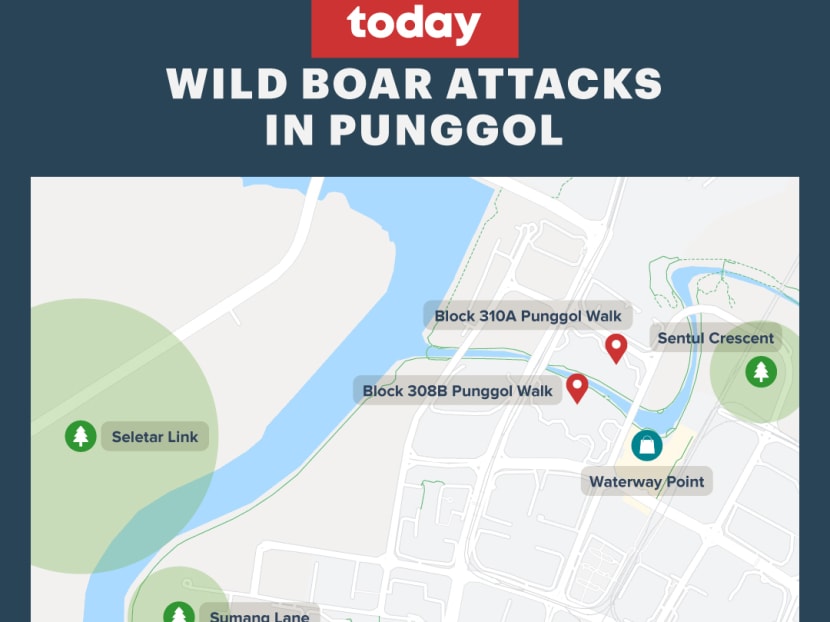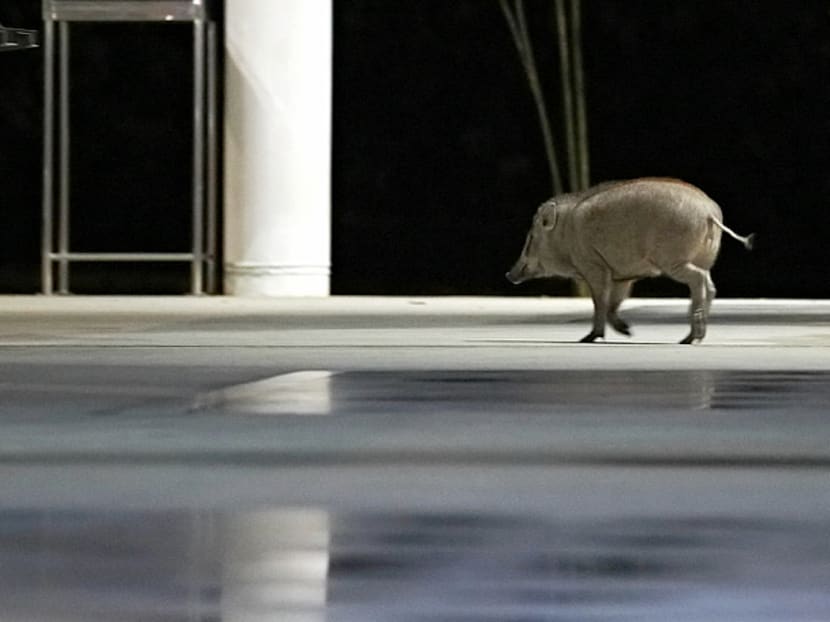Explainer: How did a wild boar venture into the heart of Punggol housing estate?
Wild boar sightings are not uncommon in Punggol. These have typically occurred around forested areas such as the Lorong Halus area bordering Pasir Ris or Punggol Road End. Wildlife experts told TODAY that the development of wild boar habitats, coupled with the connectivity of Punggol, could explain how a boar had roamed into the estate.
- Two separate incidents of wild boar attacks occurred at Punggol Walk on Feb 20
- Some Punggol residents were surprised that a wild boar had ventured so far into the housing estate
- Wildlife experts said the disruption of wild boars’ habitats could have driven it out to the estate
- It could have also travelled through park connectors and waterways to the sites of the incidents
- The wild boar could have attacked because it was frightened, disorientated or had wanted food, experts said
SINGAPORE — When two separate incidents of wild boar attacks occurred at Punggol Walk on Saturday (Feb 20), residents were surprised that a wild boar had managed to venture so far into the housing estate.
Wild boar sightings are not uncommon in Punggol. These have typically occurred around forested areas such as the Lorong Halus area bordering Pasir Ris or Punggol Road End.
However, Block 308B and Block 310A Punggol Walk where the incidents occurred are located in the heart of Punggol’s residential estate.
The two housing blocks are separated by a waterway but are connected by road. They are also a walking distance from Waterway Point mall at Punggol Central.
Wildlife experts told TODAY that the development of wild boar habitats, coupled with the connectivity of Punggol, could explain how a boar had roamed into the estate.
FROM WHERE COULD IT HAVE COME?
Given the number of forested areas undergoing development works in Punggol, the experts said that there were many “possibilities” as to where the boar might have begun its journey.
Mr Chiok Wen Xuan, a mammal researcher from the Asian School of the Environment at Nanyang Technological University (NTU), said that the boar could have been pushed out from its forested habitats around the nearby Sumang Lane and Seletar Link, which are being developed for housing projects.
He said that the boar could travel from these areas to the sites of the attack via park connectors.
“This is considered a short distance for wild boars and they can travel back and forth whenever resources run out at a certain area,” he explained.
The wild boar may have also swum across the waterway separating the two blocks where the incidents occurred, Mr Chiok added.
Ms Anbarasi Boopal, the chief executive officer of the Animal Concerns Research and Education Society (Acres), pointed out that the area around Sentul Crescent near Safra Punggol and Sam Kee LRT Station has been cleared for development recently.
The development has fragmented the habitats of wild boars, forcing them to cross the road to find other patches of forest, Ms Anbarasi said.

WHY DID IT GO SO FAR OUT?
Experts said that the wild boar could have wandered into the residential estate in search of food or a new home. It could also have been spooked by something else.
Mr Chiok said that the boar could have made its way to the estate in search of food. These food sources may be from refuse collection centres in housing estates or from people who feed wild animals.
Although there have been no reports of people feeding wild boars in Punggol Walk, it is “not too far-fetched” to think that this is already happening in Punggol Walk, given that people have been caught feeding wild boars in other areas of Punggol such as Lorong Halus, he said.
Mr Ivan Kwan, a nature guide, said that it is not unusual for a wild boar to venture this far out into an urban estate. Studies have shown that wild boars can wander a far distance.
However, they may not have been spotted at areas such as Punggol Walk before because the boars usually emerge late at night and stick to dark areas, he said.
Dr Andie Ang, the president of Jane Goodall Institute (Singapore), an animal welfare and environment conservation non-profit organisation, said that the boar could have ventured into urban areas in search of a new home.
“Some of the pigs in Punggol would have been regularly fed by people over time such that they lose their natural fear of humans. Coupled with the loss of their habitats, they would have no choice but to venture into urban spaces in search of a home,” she said.
Like Mr Kwan, Dr Ang said that it was not unusual to see wild boars in urban spaces because the impact of wildlife feeding and forests being cleared have led to more sightings of these animals these days.
Ms Anbarasi of Acres said that the boar seen last Saturday could have been “calmly grazing” before it was scared off by something, such as a dog or a car, leading it to run all the way to the two blocks from its original habitat.
In a statement on Monday, the National Parks Board (NParks) said that despite its efforts to manage conflict between humans and wild boars, such as educating the public not to feed wildlife, illegal feeding may lead to situations where wild boars pose a safety hazard to the public.
For instance, intentionally feeding or discarding food irresponsibly may lead to wild boars relying on humans for an easy source of food.
They may then venture into urban areas in search of human food sources and wander onto roads, posing a potential danger to motorists and themselves.
They may also display aggressive behaviour to people they may come across, NParks said.
“If wildlife turn aggressive due to constant feeding, they may have to be put down to safeguard public safety,” NParks said.
WHY DID THE BOAR ATTACK?
Given that it is not natural for wild boars to approach or attack people, why did it do so last weekend?
Ms Anbarasi of Acres said that if the boar had been frightened by something, it could have “blindly ran”, much like how other prey animals such as deers and zebras do.
In such an instance, a wild boar will simply bash through any object in its path, be it a dustbin or person, she added, explaining how the incidents could have happened.
Mr Chiok of NTU said that the boar may have been disorientated by the brightly lit and populated area surrounded by traffic. It could also have approached one of the victims thinking it would receive food, and then became startled when the victim panicked and reacted, he added.
Mr Kwan the nature guide said that if more forest patches continue to be developed in Punggol and factors such as food sources luring wild boar into urban estates are not addressed, more of such incidents of wild boars encountering humans in urban areas could occur.
Dr Ang from Jane Goodall Institute said that whether similar incidents of wild boars entering urban areas would occur in future depends on several factors.
These include whether there is sufficient habitat for wildlife, the presence of island-wide connectivity for animals to move between habitats without venturing into urban spaces and educating the general public on dealing with wildlife encounters.
In its recent statement, NParks reminded the public to remain calm if they encounter a wild boar and move slowly away from it.
“Keep a safe distance and do not corner or provoke the animal. If adult wild boars are seen with young piglets, keep a distance and leave them alone, as they are potentially aggressive and may attempt to defend their young.”









